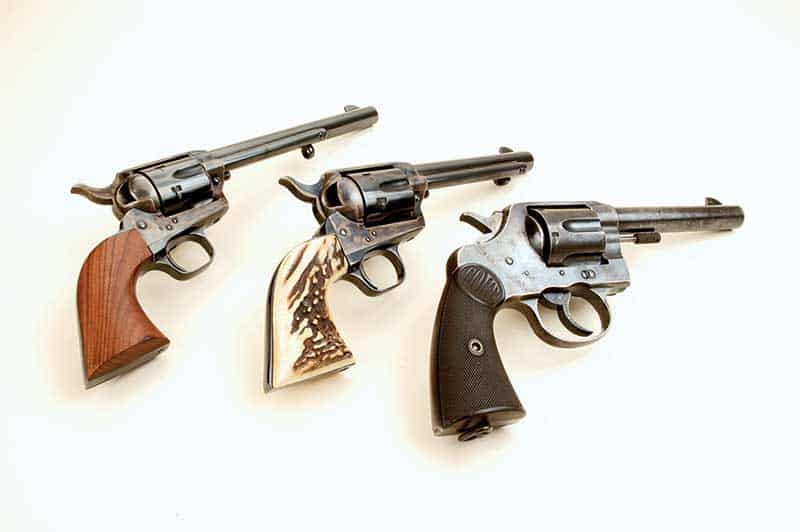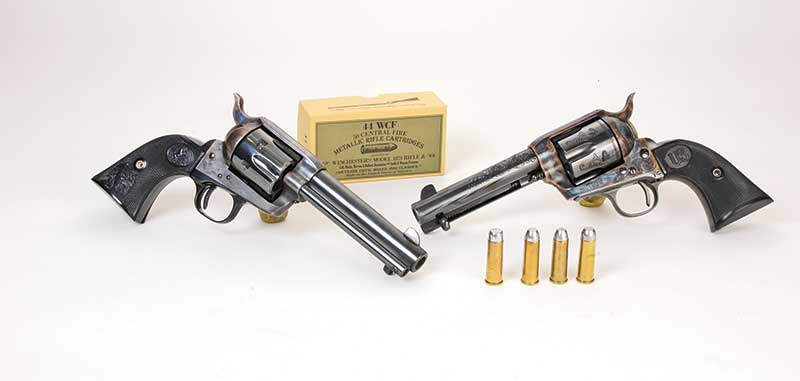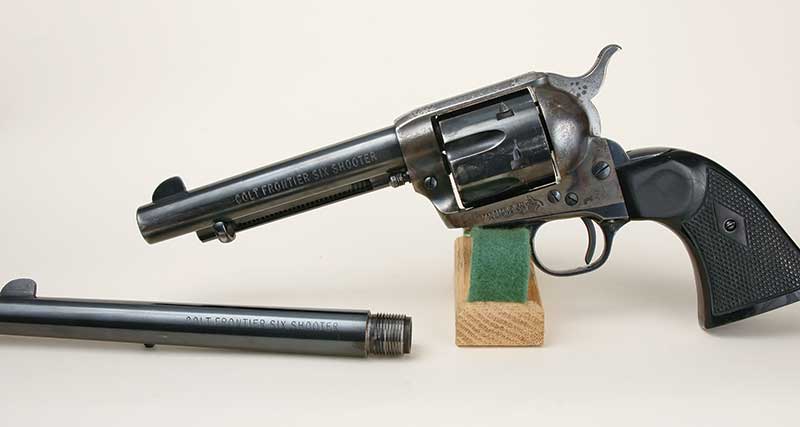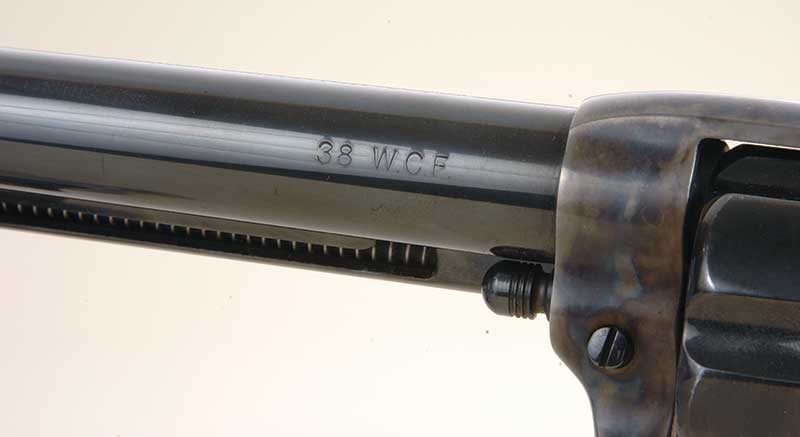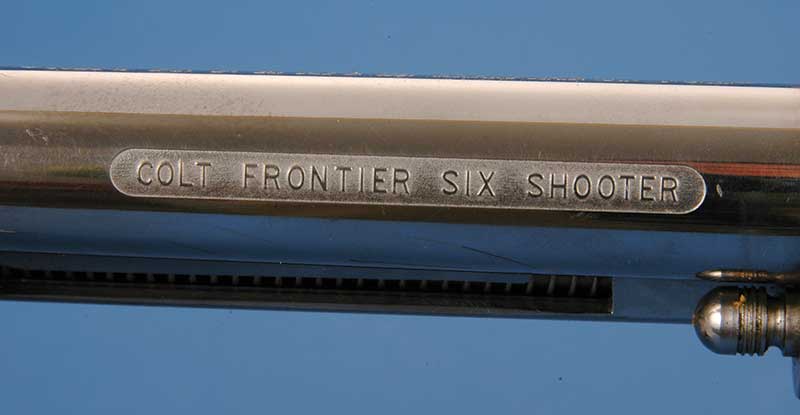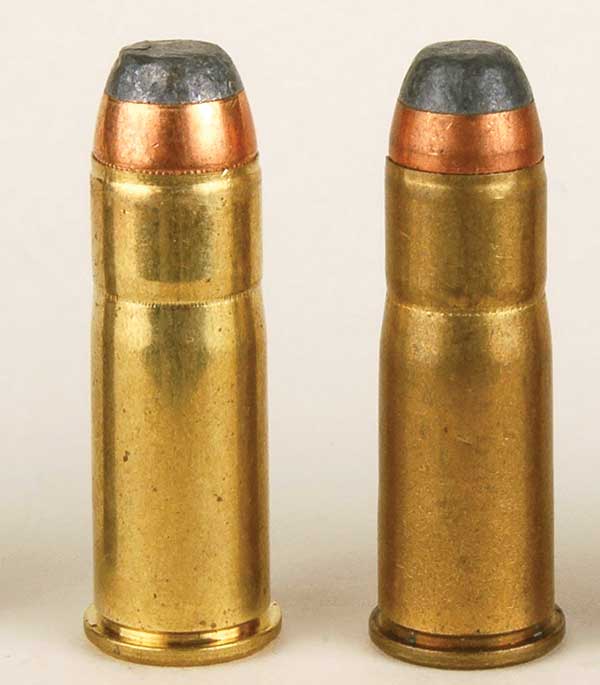Just about everyone who was a loyal Skeeter fan (and I was) managed to convert one or other type of big-frame revolver to .44 Special. Of course that was back when you couldn’t just buy .44 Special revolvers. I did that too.
Here’s how mine went. At a gun shop in Milton, W. Va., in 1976 I found a 5-1/2-inch Colt barrel marked Colt Frontier Six Shooter, which was Colt-speak for .44 WCF. It was still new in factory packing and I paid $37.50 for it. A 7-1/2-inch one was there too and I went back 10 years later and got it.
Next I rounded up a 2nd Generation Colt SAA .357 Magnum into which I had a gunsmith put that barrel. And then finally by also switching out the cylinder hand I was able to use a new 3rd Generation .44 Special cylinder. It is a fact Colt always used the same barrel dimensions for .44 Special and .44 WCF (0.427 inch to be exact).
The .38 & .44 WCF
Winchester's Two Most
Popular Old West Cartridges
Served Equally Well In
Revolvers Of The Day
My early years as a Colt SAA shooter included quite a bit of floundering in regards to what I liked. My very first one purchased in 1968 was a .45 with 5-1/2-inch barrel length. I was happy with it because I knew no other. The second was a .357 Magnum purchased in 1970 and it had the 4-3/4-inch barrel. Within hours of driving away from the store I knew a mistake had been made. To me that Colt just did not have the proper feel and heft. Both of those had color case hardened frames with blued remainder.
My third SAA came in 1971. It was a .38 Special with 4-3/4-inch barrel and was fully nickel-plated. Besides feeling exactly like the .357 in my hands, I considered it rather garish and sold it for a $25 profit two years later. A decade passed and I realized my mistake upon discovering in the 2nd Generation of Colt SAA production only 113 were made with combination of nickel finish, 4-3/4-inch barrel and .38 Special chambering.
Now, with 47 years of Colt SAA shooting under my belt I know exactly what I like. No longer does nickel-plating seem garish. I welcome nickel finish because it is easier to clean black powder fouling from, which I am sure was the reason why so many late 19th century revolvers were nickeled. And while 4-3/4-inch barrel lengths have a “look” and are likely the best-selling SAA’s today from Colt and many other replica manufacturers, I’ve come to prefer the 7-1/2-inch length. That said, I still like and keep all the standard SAA barrel variations.
And here’s the icing on the cake: The SAA’s I prefer over all others are chambered for the .38 and .44 WCF’s. That’s right—I prefer my Colt SAA’s to shoot cartridges developed by Winchester Repeating Arms over anything Colt ever developed. Consider this: Except for the big .45, Colt’s 19th century cartridge developments were dismal. The .38 Colt, .41 Colt and .44 Colt went exactly nowhere in the long run.
But the .38 WCF and .44 WCF, which we 21st century shooters usually call .38-40 and .44-40, were humdingers right from the start. Skeeter Skelton, of gunwriting fame once wrote that old Southwestern lawmen felt the .38 WCF “shot hard.” Col. Charles Askins, also a notable gunwriter wrote he saw no reason for the .44 S&W Special to ever have been invented because it did nothing the .44 WCF could not do.
Like just about every reader from my Medicare-aged generation I was influenced by Elmer Keith and Skeeter Skelton. They were great fans of .45 Colts and .44 Specials in regards to SAA’s. I really tried to follow their lead but it just didn’t happen. My opinion is the .45 Colt was the ultimate black powder revolver cartridge, but its case capacity is just too big for smokeless powders unless you’re loading it for some super strong sixgun like the Ruger Bisley or Freedom Arms’ .454 five-shooters.
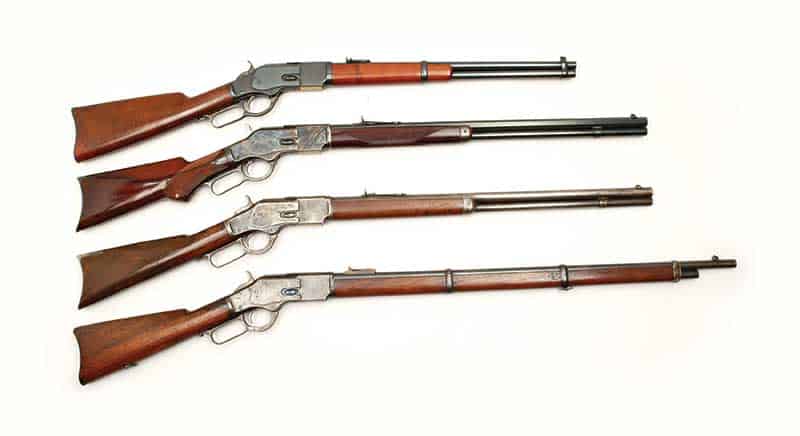
One reason Duke prefers the .38 & .44 WCF cartridges is their compatibility with lever guns in
the same chambering, all originating in the Winchester Model 1873. Duke’s battery includes (from top)
a Cimarron saddle ring carbine .38 WCF, Cimarron Arms Sporting Rifle .44 WCF, Winchester
standard rifle .38 WCF, and Winchester Musket .44 WCF. Photos: Yvonne Venturino
That Colt .44 Special stayed that way for years and Yvonne took to carrying it with her when riding one of her horses about the Montana hills. Then when she began shooting Cowboy competition with me I got a 3rd Generation .44 WCF cylinder fitted to it so she could use the same ammo as her Winchester Model 1892 lever gun. The .44 Special cylinder has not been re-installed for a couple of decades.
Without a doubt, the ability to use the same ammo in lever guns and SAA’s counts for my preference for .38 and .44 WCF. I have several .38 WCF and .44 WCF Model 1873 and Model 1892 Winchesters in my racks. I used to occasionally hunt deer with the .44’s but never used the .38’s on anything but small varmints. Mostly they were fired in Cowboy Action matches to the tune of several thousand rounds. That’s where the concept of sharing ammunition with revolvers really shines.
Here’s another area where I differ from many Colt SAA fans. I am not disdainful of 3rd Generation manufacture. I admit Colt went through some rough times with early fit and finish of 3rd Generation SAA’s. Those started in 1976 and through the 1980’s the Colt firm deserved the sneers gun buyers gave to some of their products.
Conversely, some of the best Colt SAA’s I’ve ever owned were made in the 1990’s, especially the .38 WCF’s. In the 1st Generation of production (1873-1941) Colt was loose in regards to dimensions. In .38 WCF I’ve slugged barrels running from 0.401- to 0.408-inch. Conversely every modern made .38 WCF’s barrel I’ve measured has been right on at 0.400-inch across its grooves. Matching that have been chamber mouths of 0.401-inch. I’ve owned no less than eight of the 1990’s .38 WCF’s and all have been superbly accurate because of those closely matched dimensions. (I also have a Colt New Service .38 WCF from 1908. Its barrel/cylinder dimensions are 0.400-inch for both.)
There can be one trouble spot with new made Colt SAA .38 WCF’s. That is in regards to chambering handloaded ammunition. Actually the problem is with some reloading dies and not with the revolvers themselves. Some dies simply do not set the shoulder of fired .38 WCF cases back far enough for easy chambering in the Colt SAA. My set was made by RCBS in 1983 and does an exemplary job in that respect. Some of my friends have had a bit of steel taken off the base of their resizing dies so that case shoulders are moved back far enough.
At this writing I have two Colt SAA, 3rd Generation .38 WCF’s left of the eight I’ve owned. Incidentally, here I’m using the .38 WCF name purposefully instead of the much more common .38-40. That’s because mine are barrel-stamped with the original moniker .38 WCF instead of .38-40, as were most of the early 1990’s resurrections. One of these sixguns has a 5-1/2-inch barrel and one has a 7-1/2-inch barrel. Neither have their original grips. On the shorter one there are a set of very old stag grips and on the longer one there are a set of 1-piece style grips of rosewood. The latter ones were crafted by my friend Tom Sargis who also slicked up their actions.
I kind of cheat a bit in regards to my favorite .44 WCF’s. Those are commemoratives never actually intended for shooting. Colt called them Peacemaker Centennials. They were made precisely as Colt Frontier Six-Shooters were in the 1870’s: nickel-plated with 7-1/2-inch barrels, etched panel with Colt Frontier Six-Shooter and even down to the tiny “.44 CF” on the left side of the triggerguard. Somehow or other 1970’s Colt engineers got their barrels and chambers dimensions correct. Barrels are 0.427-inch and chamber’s mouths are 0.429-inch. I have a matched set.
My other matched set of Colt Frontier Six-Shooters was made in the 1990’s. During that time Colt still offered the so-called black-powder frame, which has a screw angling in from the front to secure the base pin. I ended up with a pair with consecutive serial numbers, 4-3/4-inch barrels and blue/case color finish. Those are also stamped Colt Frontier Six-Shooter and were also slicked up by Tom Sargis.
It is doubtful if I’ll ever buy anymore Colt SAA’s in any caliber. I’ve got more than ever could be worn out anyway. Besides, I know exactly what handloads suit these on hand now. For the .38 WCF I either cast my own bullets in RCBS mold 40-180CM or use ones from Oregon Trail Cast Bullets made in that fine Magma Engineering mold. These bullets weigh 180 grains, are roundnose/flatpoints and have their crimping grooves located precisely where needed for functioning in tubular magazine lever guns and pump actions. Bullet size is 0.401-inch. Into the Starline brass goes 5.5 grains of IMR’s Trail Boss powder with a sturdy crimp placed in the proper groove. Velocity from a 7-1/2-inch barrel is about 825 fps.
With the .44 WCF’s I load RCBS bullet 44-200FN. It weighs 200 to 210 grains depending on exact alloy. If I run short of time I buy this same bullet from a custom casting operation, Montana Cast Bullets. Mine are sized .428-inch but the custom cast ones are .429-inch. Those are then seated in Starline cases over 6.0 grains of Trail Boss and crimped securely. Those loads break about 800 fps from a 7-1/2-inch barrel.
Other Colts are fired for articles, but these .38 and .44 WCF’s are my personal shooting favorites.

These two cartridges are vintage .38 and .44 WCF cartridges (above) loaded with lead bullets
and black powder. Bullet weights were 180 and 200 grains in the same order. They were
powerhouses in their day and not too shabby even today. Today, new manufactured .44 and
.38 WCF rounds (bottom) as factory loaded by Winchester. Bullet weights again are 200 and
180 grains in the same order. Because of the small amount of smokeless propellant, Winchester
has added a cannelure below the bullet to prevent the bullets from telescoping into the case.
Montana Cast Bullets
527 West Babcock
Bozeman, MT 59715
Tom Sargis Jr.
Bozeman Trail Arms Mfg.
28 Lake Dr.
Livingston, MT 59047
(406) 223-1111
www.bozemantrailarms.com

